Every once in a while, a vehicle rolls out of the factory so awe-inspiring, that it immediately grabs your attention. This is that vehicle.
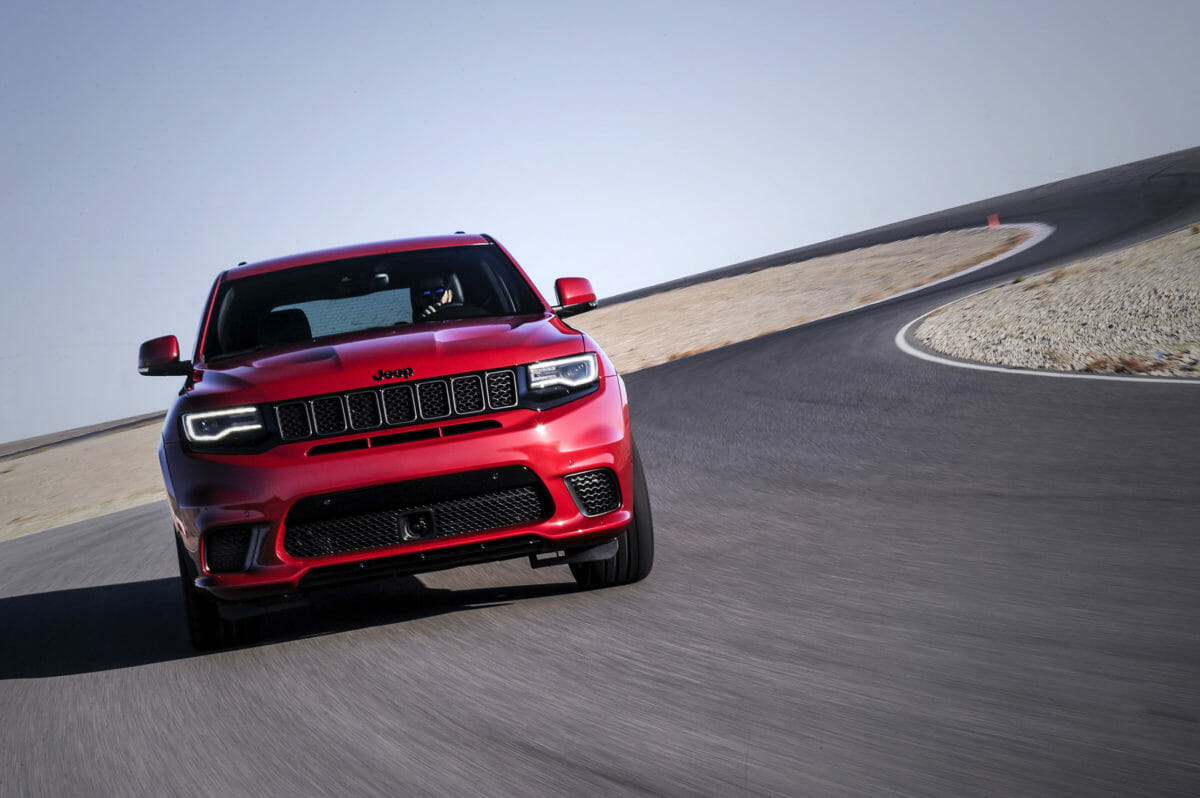
The modern sport utility vehicle dates back to 1984 when Jeep introduced the Cherokee (XJ). So, it is only fitting that they did something completely crazy with the current five-passenger Grand Cherokee.
What did they do, you ask? They knocked on Dodge’s garage and asked to borrow a fire-breathing 707 horsepower V8 engine. Then they crammed it under the pedestrian Grand Cherokee’s hood, making it one of the fastest SUVs on the road.
Actually, for sheer acceleration, it’s one of the fastest vehicles on the road. What goes into something like this, and should you consider purchasing one? Let’s find out by checking out the history of ideas and innovations that led to the Jeep with the Hellcat Engine.
How Did This Even Happen?
It’s not an odd question to ask: How did the Jeep Trackhawk even come into existence? We know that when it comes to awesome and unique innovations, the good folks at Dodge are slightly off, in a good way.
They have crammed the 707 horsepower engine from the Dodge Challenger into several other vehicles — basically everything in the lineup besides the Grand Caravan. But exactly how did it end up crossing over into the Jeep lineup?
Well, the answer, as publicized in several interviews with the SRT (Street & Racing Technologies) team responsible for creating this beast was “why not.” They noted that buyers were asking for a hot rod Jeep, and they obliged.
Still, it wasn’t quite that easy. Making a daily driver Grand Cherokee into something with the name “Trackhawk” took some forethought and engineering. Companies like Mercedes-Benz, Maserati, Porsche, and BMW are all producing hot-rod versions of their SUVs, and they sell quite well. So, from a sales perspective, it actually makes sense.
Plus, something this ludicrous makes for a good headline and additional press that might get buyers into showrooms. Even if they end up buying a more mundane Jeep, it was worth it.
Luckily the Trackhawk had a predecessor to lay the groundwork for a performance SUV at Jeep. The Jeep Grand Cherokee SRT 392 has been on the market since 2012.
Powered by a 475 horsepower 6.4L Hemi V8, it is no shrinking violet. With upgraded brakes and suspension, plus a more aggressive exterior, it was a good starting point for the Trackhawk.
However, the Grand Cherokee still had to undergo some modifications under the hood to accommodate the Hellcat’s engine. Additionally, upgrades to the drive shaft, half shafts, and transfer case were done to help handle the 645 lb.-ft. of torque that the engine puts out.
A new eight-speed ZF “HP95” paddle-shift transmission was also mated to the engine to make sure power could be put to the ground effectively. Naturally, the Trackhawk is all-wheel-drive, sharing its specialized system with the Grand Cherokee SRT.
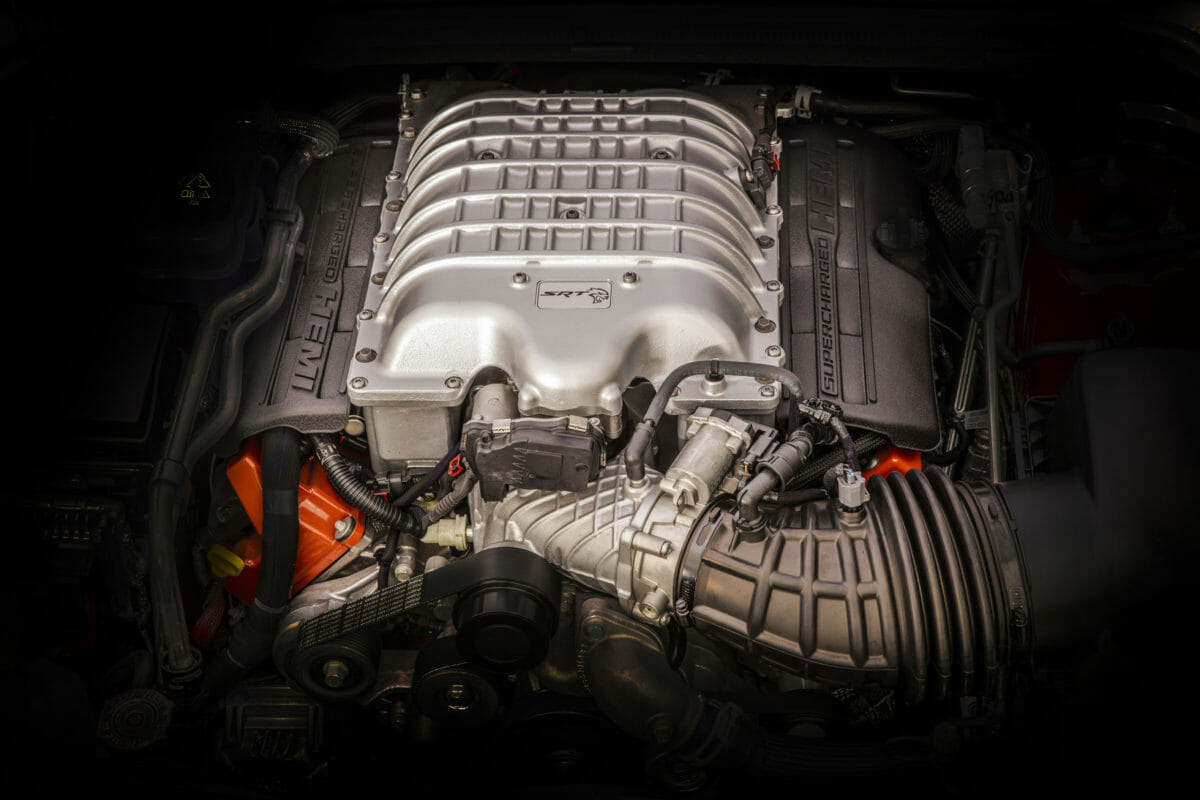
Trackhawk Engine Specs
The heart of the Trackhawk is most certainly its bombastic engine. Vehicle History has a much more detailed explainer about how the Trackhawk’s engine works, but here are the basics.
Named after a World War II fighter aircraft, the Hellcat Hemi V8 debuted in 2014 and starts with the 6.4-liter Apache block. This particular, slightly smaller, 6.2L engine has a shortened stroke, thus the difference in overall displacement. That matters less since the Hellcat engine is supercharged.
The IHI supercharger utilizes an electrically controlled bypass valve which can max out at around 11.6 psi of pressure. What you end up with is 707 horsepower delivered at 6,000 rpm and 645 lb.-ft. of torque, peaking at 4,800 rpm. It’s quite a thing, to say the least.
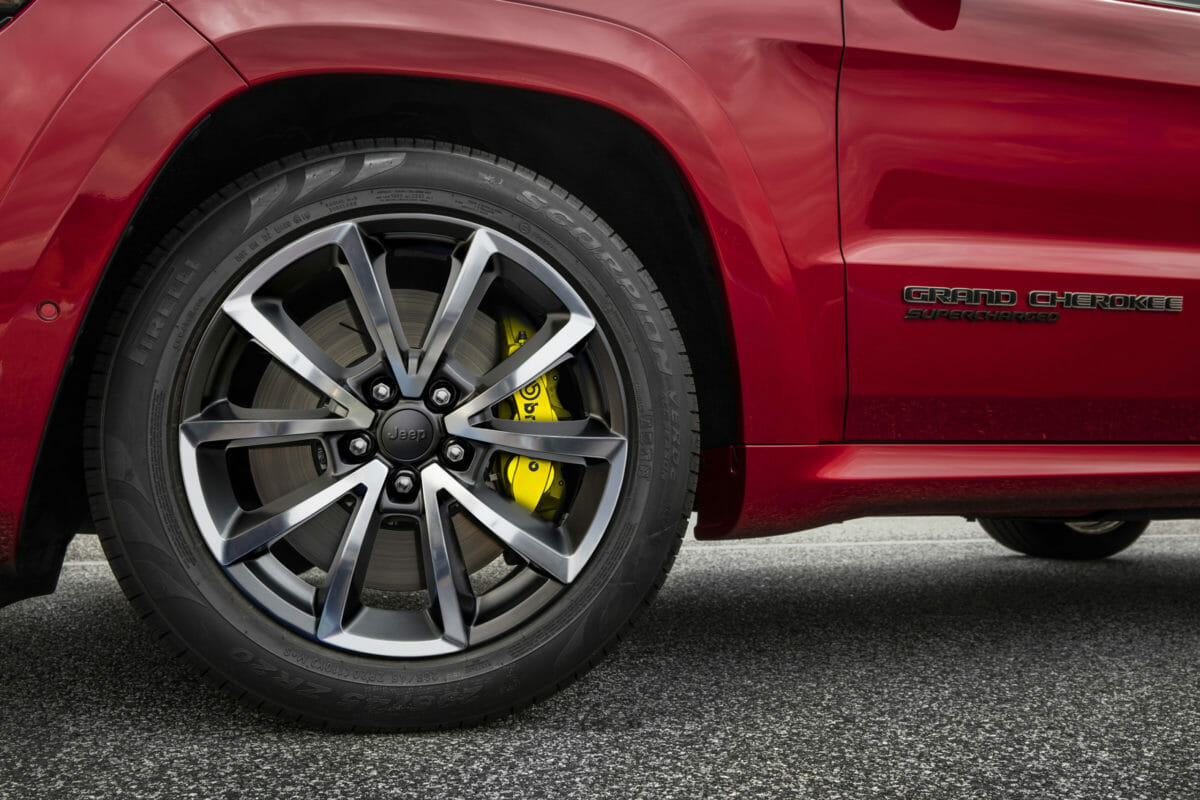
Trackhawk Suspension & Brakes
Naturally, the Trackhawk doesn’t just ride on an old stock Grand Cherokees suspension. An upgraded adaptive suspension was built to make sure the Trackhawk can actually tackle a track, vs. the dirt trails that most Grand Cherokees are built for.
The basis of the Trackhawk’s suspension is derived from the Grand Cherokee SRT, its aluminum-focused suspension gets some upgrades though. The front suspension uses a short and long arm, while the rear suspension is multi-link. And even though the overall independent front and rear geometry is about the same as what you will find in the SRT, you’ll find nine percent stiffer spring rates in the front and 15 percent stiffer in the rear.
SRT even retuned the Bilstein three-mode adaptive dampers for better stability and ride quality. Extra stability also comes from the overall width. The Trackhawk is 1.3 inches wider in the front, and 0.1-inch wider in the rear compared to the SRT. All that adds up to a pretty well-balanced SUV.
The SRT utilizes a pretty substantial Brembo brake setup.
However, with another 212 horsepower on tap, plus a bit heftier curb weight, the Trackhawk foregoes the standard Brembo brakes, using two-piece discs with aluminum hats and iron rotors.
Impressive six-piston calipers are paired with larger 15.7-inch discs on the front (0.8 inches bigger), however, the rears remain the same as the SRT at 13.8 inches. Look for the bright yellow calipers and you’ll know it’s a Trackhawk!
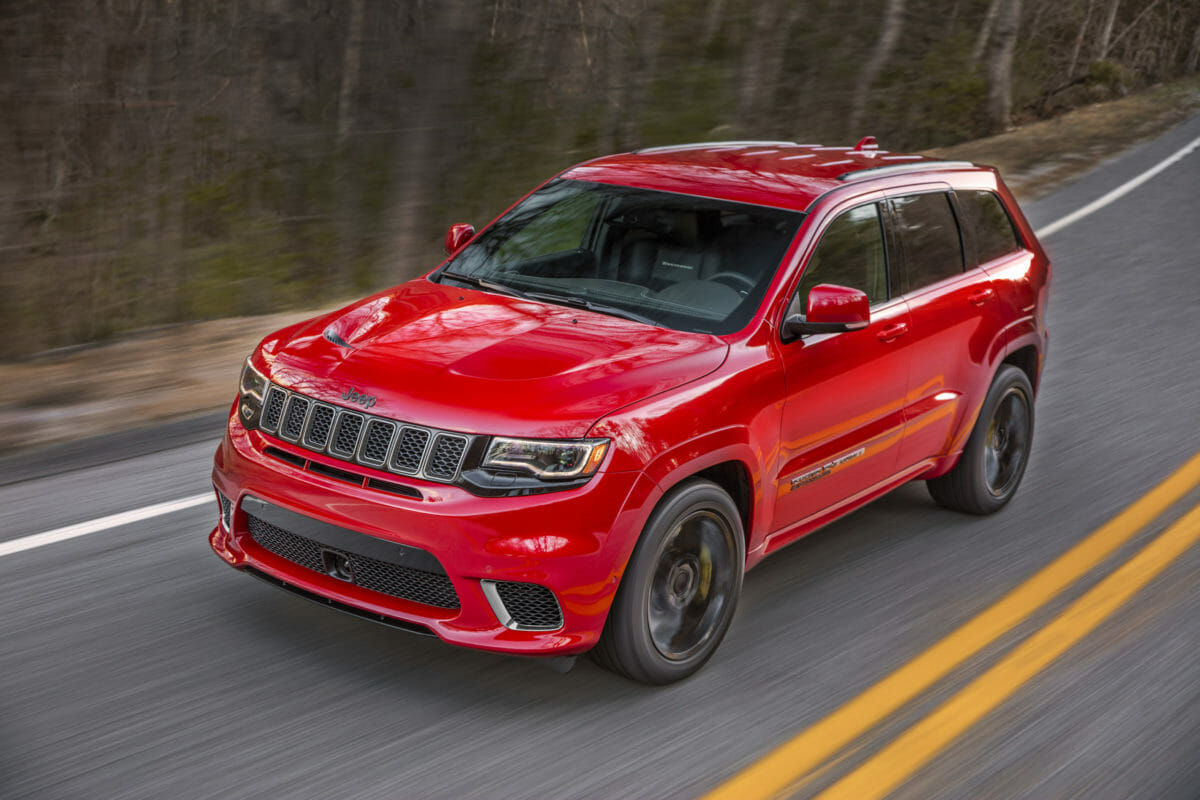
Trackhawk Exterior & Interior
Oddly enough, you might expect a 707 horsepower SUV to have over-the-top styling. Function over form rules the day, so that actually isn’t the case for the Trackhawk.
Aside from the bright yellow brakes, which are easy to spot, you’ll have to look hard to discern a Trackhawk from an SRT. It has model-specific wheels, a larger vented hood, smoked headlights, and four exhaust tips surrounded by black trim. Add some Trackhawk badging, plus a few “Supercharged” badges and you’ll have to admit, the Trackhawk is surprisingly subtle.
However, subtle doesn’t mean unattractive. The WK2 generation, the Grand Cherokee’s fourth generation, is a very handsome SUV and blends in with some of Europe’s best-looking competitors. The standard 20″ x 10″ polished forged aluminum wheels come with “Titanium II” painted pockets and satin-chrome wheel center caps.
They are pretty good-looking, like a lot of SRT wheels. Opt for the 20″ x 10″ loss gloss black lightweight aluminum wheels with gloss black wheel center caps if you want to stand out a bit more.
Jeep Grand Cherokee Trackhawk Colors (2018-2021)
Exterior color options come from a palette that includes Billet Silver Metallic, Bright White, Diamond Black Crystal, Granite Crystal Metallic, Green Metallic (2019+), Ivory Tri-coat (+$595), Redline 2 Coat, Rhino (2018 only), Slate Blue (2019+), Sting Grey (2019+), True Blue (2018 only), and Velvet Red. Inside, the Jeep Grand Cherokee Trackhawk doesn’t go too far overboard.
However, there are some unique interior design elements and upgraded upholstery to make sure you know it’s special. You’ll find a cool flat-bottom steering wheel, just like in your favorite supercar. The rest of the interior is pretty standard fare, but with an optimistic 200 mph speedometer and Trackhawk sill plates to greet you at the entrance.
With regard to interior practicality, it’s just as good as a normal Grand Cherokee. Passenger volume is 106 cu-ft and cargo volume comes in at 36 cu-ft with all seats in place, or 68.3 cu. ft. with the rear seats folded. As far as the interior color palette goes, see below.
Jeep Grand Cherokee Trackhawk Interior Colors:
- Nappa performance seats in black with black suede inserts and black dashboard
- Nappa performance seats in sepia with sepia suede inserts and black dashboard
- Laguna leather performance seats in black with black dashboard
Thankfully, considering the high price tag (more on that later), the cabin is quite comfortable and comes with a ton of standard features. You’ll find the latest UConnect touchscreen infotainment system, one of the easier systems on the market to use, plus eight-way power front seats with heating and cooling, plus a lot more.
Optional packages include a high-performance audio system and a DVD rear entertainment system in case you want to rock out to something other than the sounds of a supercharged V8.
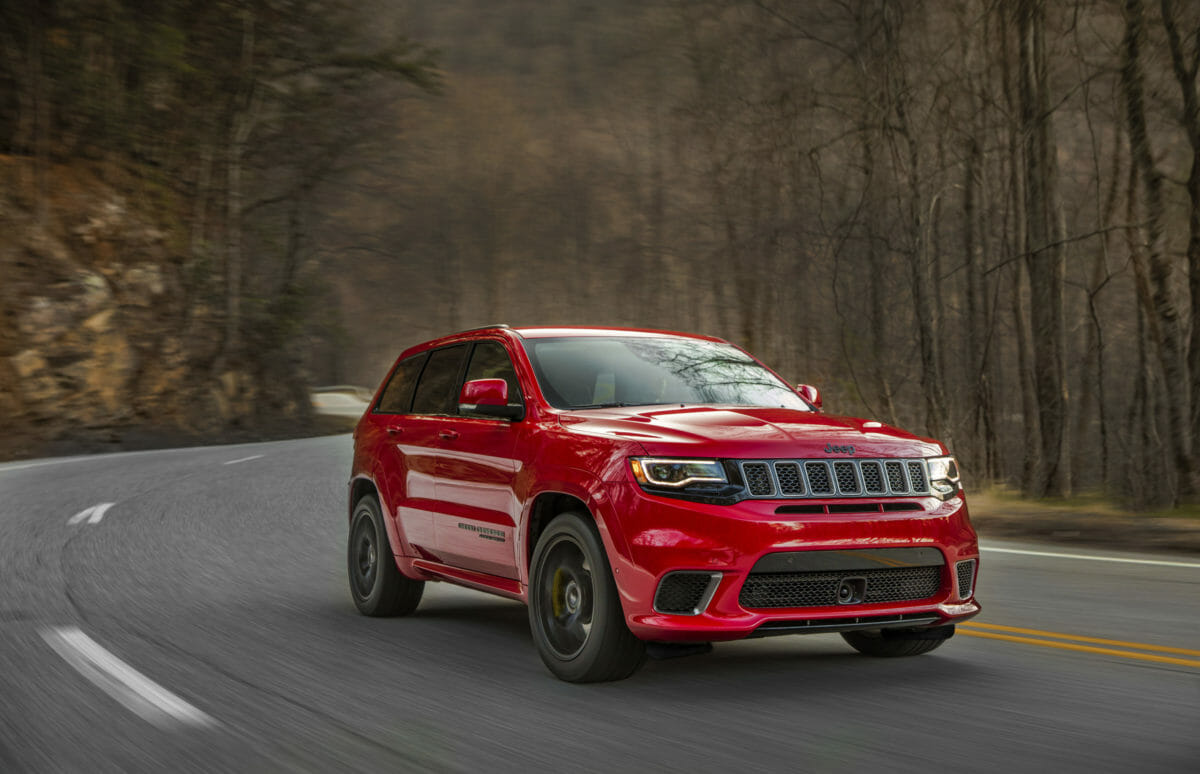
Trackhawk Performance
Even though it looks understated, its performance numbers are far from dull. The trip from a standstill to 60 mph is a mere 3.5 seconds. One hundred mph will arrive in under nine seconds. The Trackhawk uses a little something called “launch control” to effortlessly help you get there. Select it from the touchscreen menu and pin your left foot on the brake and your right foot on the gas.
The system will take it from there and will cut fuel delivery to individual cylinders. This means the engine can rev higher and the supercharger can build more boost. Lift your foot off the brake and the Trackhawk will spin all four of the 295/45ZR-20 Pirelli tires.
If you’ve ever done it–we have!–then you know that it’s amazing…if a bit terrifying.
The standing quarter-mile will flash by in 12 seconds or less and the top speed is a manufacturer claimed (and drag limited) 180 miles per hour. Told you that the 200 mph speedometer was optimistic. Still, it’s all quite impressive.
The trip from 70 miles per hour to zero will take about 186 feet and she’ll pull an impressive 0.89 g’s on the skidpad. Yeah, all that in a 5258 pounds SUV.
Trackhawk Pricing
So, are you ready for Jeep Grand Cherokee ownership? Make sure you’re ready for the price tag. It’ll run you more than twice what a base Laredo of a comparable year will cost you, average prices go from just under $68,000 up to well over $90,000. You can build your own 2021 Trackhawk, pricing starts at around $88,000.
Also, don’t forget to factor in the EPA mileage estimated 11 City and 17 Highway mpg rating. If you plan to drive your Trackhawk for any significant amount of miles, gas prices will rack up.
- 2018 average price range: $67,784-$76,195
- 2019 average price range: $75,931-$84,786
- 2020 average price range: $83,663-$92,844
- 2021 average price range: $87,650-MSRP
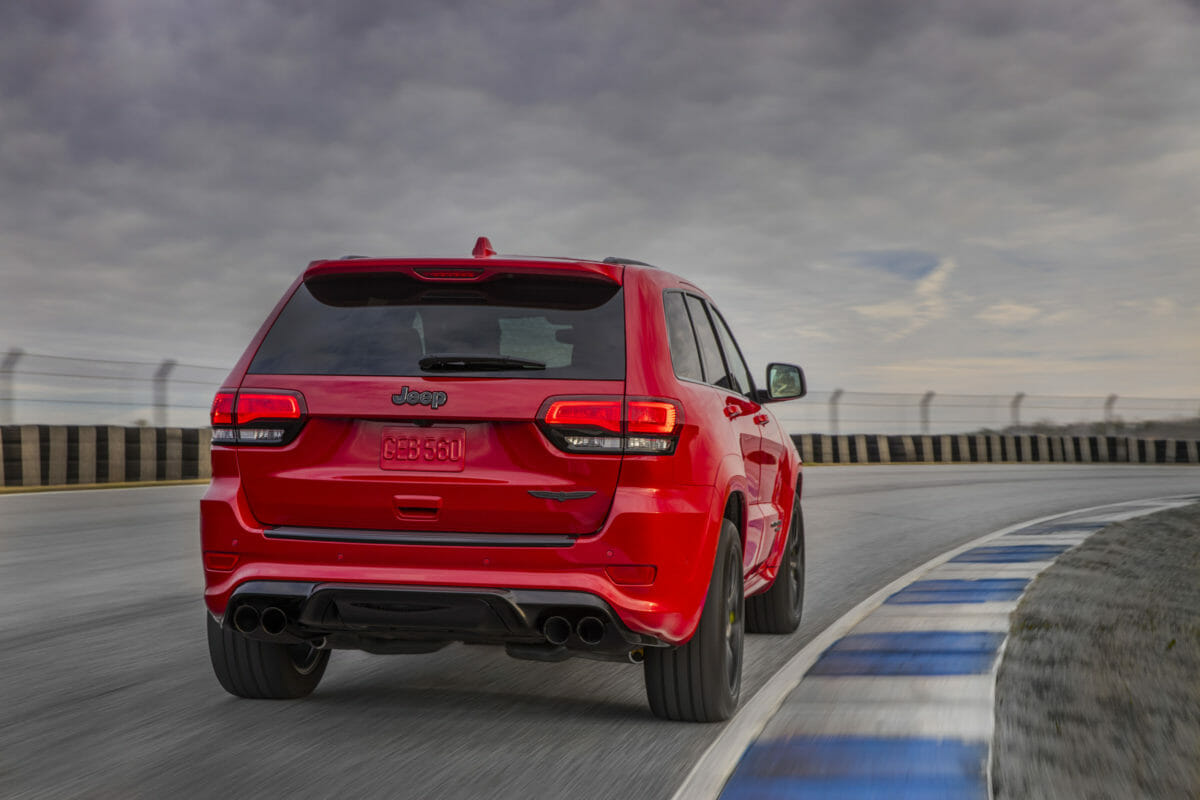
Should You Buy a Jeep with Hellcat Engine?
Is a Jeep Grand Cherokee with Hellcat engine a good investment for car buyers looking for power, performance, and style? Absolutely! However, we take no responsibility in whatever happens after that — because this is one beautiful and powerful road beast. Make sure you know what you are getting into.
The Grand Cherokee Trackhawk looks like a regular SUV, and it even drives like one on the daily commute.
However, once you put your right foot down, it covers an amazing amount of tarmac in a hurry. If you are ready for that, it’s worth the price of admission. If you are buying used, get a good pre-purchase inspection, the Trackhawk is a complex cat.
Plus, always check the NHTSA for open recalls for your new Trackhawk to help stay safe. Regardless, we live in an amazing world where the Jeep Grand Cherokee Trackhawk exists.
Photos: Jeep
